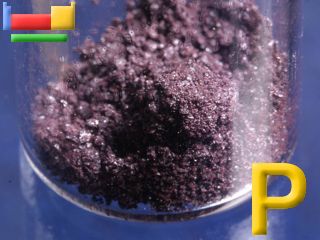
http://www.webelements.com/webelements/elements/text/P/key.html
Originally, phosphorus was extracted from urine. However there is plenty of phosphorus in phosphate ores and those ores represent the usual source for commercially produced phosphorus. There is normally no need to make phosphorus in the laboratory as it is readily available commercially.
The usial route involves heating a phosphate with sand and carbon in an electric furnace. It is highly energy intensive.
2Ca3(PO4)2 + 6SiO2 + 10C (1500°C) 6CaSiO3 + 10CO + P4
The reaction may proceed via "phosphorus pentoxide", P4O10.
2Ca3(PO4)2 + 6SiO2 + 6CaSiO3 + P4O10
P4O10 + 10C 10CO + P4
http://www.luminet.net/~wenonah/hydro/p.htm
Very good info on physical properties.
http://www.specialchem4polymers.com/sf/Italmatch/index.aspx?id=FR
The term Red-phosphorus (P-red) is used for describing one of the allotropic forms of Phosphorus, obtained by heating White Phosphorus (P-w) at a temperature close to 300C in absence of oxygen.
The colour ranges from the orange to the dark violet depending on molecular weight, particle size and impurities. P-red is largely amorphous inorganic polymer, although X-rays have established the existence of several crystalline forms, normally present in a limited extend (<10%w).
http://pearl1.lanl.gov/periodic/elements/15.html
Properties
Phosphorus exists in four or more allotropic forms: white (or yellow), red, and black (or violet). Ordinary phosphorus is a waxy white solid; when pure it is colorless and transparent. White phosphorus has two modifications: alpha and beta with a transition temperature at -3.8oC.
It is insoluble in water, but soluble in carbon disulfide. It takes fire spontaneously in air, burning to the pentoxide.
Handling
It is very poisonous, 50 mg constituting an approximate fatal dose. Exposure to white phosphorus should not exceed 0.1 mg/m3 (8-hour time-weighted average - 40-hour work week). White phosphorus should be kept under water, as it is dangerously reactive in air, and it should be handled with forceps, as contact with the skin may cause severe burns.
When exposed to sunlight or when heated in its own vapor to 250oC, it is converted to the red variety, which does not phosphoresce in air as does the white variety. This form does not ignite spontaneously and is not as dangerous as white phosphorus. It should, however, be handled with care as it does convert to the white form at some temperatures and it emits highly toxic fumes of the oxides of phosphorus when heated. The red modification is fairly stable, sublimes with a vapor pressure of 1 atm at 17C, and is used in the manufacture of safety matches, pyrotechnics, pesticides, incendiary shells, smoke bombs, tracer bullets, etc.
Production
White phosphorus may be made by several methods. By one process, tri-calcium phosphate, the essential ingredient of phosphate rock, is heated in the presence of carbon and silica in an electric furnace or fuel-fired furnace. Elementary phosphorus is liberated as vapor and may be collected under phosphoric acid, an important compound in making super-phosphate fertilizers.
http://www.scescape.net/~woods/elements/phosphorus.html#reactions
http://chemlab.pc.maricopa.edu/periodic/P.html
http://www.vcs.ethz.ch/chemglobe/ptoe/_/15.html
Found most often in phosphate rock. Pure phosphorus is obtained by heating a mixture of phosphate rock, coke, and silica to about 1450 °C.
http://www.chemsoc.org/viselements/pages/phosphorus.html
There are several forms of phosphorus. White phosphorus is manufactured industrially, glows in the dark, is spontaneously flammable when exposed to the air above 30°C and is a deadly poison. Red phosphorus, made by gently heating white phosphorus in the absence of air to about 250°C, does not glow, is stable and is not poisonous. This is the material, mixed with powdered glass, stuck on the side of boxes of safety matches on which the matches must be struck to light them.
http://education.jlab.org/itselemental/ele015.html
Phosphorus has three main allotropes: white, red and black. White phosphorus is poisonous and can spontaneously ignite when it comes in contact with air. For this reason, white phosphorus must be stored under water and is usually used to produce phosphorus compounds. Red phosphorus is formed by heating white phosphorus to 250°C (482°F) or by exposing white phosphorus to sunlight. Red phosphorus is not poisonous and is not as dangerous as white phosphorus, although frictional heating is enough to change it back to white phosphorus. Red phosphorus is used in safety matches, fireworks, smoke bombs and pesticides. Black phosphorus is also formed by heating white phosphorus, but a mercury catalyst and a seed crystal of black phosphorus are required. Black phosphorus is the least reactive form of phosphorus and has no significant commercial uses.